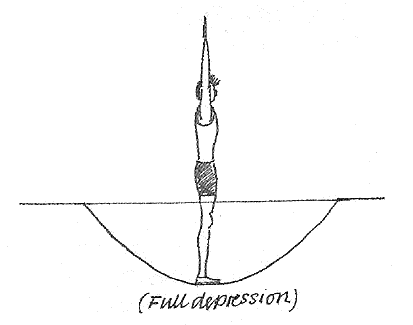Understanding Landings
In previous articles I have placed great emphasis on the importance of sound take off technique and the efficient use of the trampoline’s unique rebound characteristics. Now I want to turn our attention to the importance of correct landings with a particular focus on the back somersault. Having said that, the principles described apply to all skills which finish with a backward component like barani, rudolph and all the back twisters. Indeed it is relevant for all the fliffus and triffus skills which make even greater demands on the technique as they too finish with a backward component.
Regular readers may recall my first article "A Fresh Look at Take Off” (Feb/March 2003) which asked the question “when have you landed?” and went on to state that there is no such thing as a “landing” on the trampoline. I argued it makes no sense to state that the performer “lands” when the feet touch the bed i.e. the point of first contact. Perhaps it makes more sense to describe the point of full depression as the “landing” but that too, is an unhelpful concept when the coach is trying to develop the gymnast’s understanding of correct technique and timing. I proposed that we talk about the “landing phase,” namely, first contact to full depression and the “take off phase” being full depression to last contact. Please forgive my repetition of this, but the concept must be firmly grasped in order to appreciate what follows.
The two most common faults in the production of back somersaults are:
- Poor direction of force during the take off phase resulting in travel and height loss.
- Overthrow. i.e. the somersault has rotated too far by the time first bed contact is made. (Fig 1)

Fig 1
At first sight one could be forgiven for thinking that Fig 1 shows a perfect “landing” but let us examine the folly of this thinking. Although we can appreciate that a somersault rotates in the air, it is less obvious that as the feet make first bed contact, rotation continues with the feet now acting as the pivot point. So making first bed contact as shown in Fig 1 masks the fact that the performer will rock backwards as shown in Fig 2.

Fig 2
This is simplistic and has not taken account of the fact that the “landing” surface does not remain stable as in a solid floor but effectively drops the performer into the hole they have just created. (Fig 3)

Fig 3
Trampolinists become very skilful at dealing with this overthrow because when they feel the initial loss of balance as the bed begins to sink beneath them, the knees are bent and/or the hips are pushed violently forward. This has the effect of slightly “killing” the bounce and limiting the balance loss thereby preventing the subsequent backward somersault from travelling dangerously. (Fig 4)

Fig 4
The payoff however is a significant loss of height and serious control problems in the subsequent somersaults in the routine. It is not an exaggeration to state that this technique (for it is a technique) is the most widespread and limiting problem in British trampolining — up to and including our top international performers.
High performance trampolinists are extremely subtle in their use of the technique, to the point where it is barely discernable, but with an average of five backward take offs in a routine, the cumulative effect is perceived as a flat, lack lustre performance finishing at least a metre below the starting height. This is one of the main reasons why many of our top trampoline gymnasts perform lower routines than the world’s best. I am deeply concerned by the number of our talented young trampolinists who repeatedly overthrow their back somersaults thereby grooving this natural but damaging compensatory technique.
In my last two articles I challenged coaches to think about their communication and examine what they really wanted their gymnasts to do. Well here I go again! Do you ask your gymnast to “land with your arms up ready for the next take off.”? Examine this in the light of my earlier explanations. For a start, what did you mean by “land”? What did the gymnast think you meant by “land”? My observations at recent national competitions and, dare I say, National Youth Squad suggest that many performers believe that Fig 1 represents the correct technique!
When a child learns a back somersault, the main objective for both coach and pupil is to guarantee a safe landing. By the time the child is ready to perform unaided the responsible coach will have made sure the pupil is capable of making first bed contact in an almost upright position. This is totally acceptable in the early stages of learning but gradually the gymnast must be coached into accepting a much shorter touch down. (Fig 5)

Fig 5
Here the weight is slightly in advance of the feet in order to deal with the natural residual rotation from the somersault and the arms are down but beginning to swing forward and up as the bed begins to depress. As the performer drops into the “hole” the rotation around the feet continues but most importantly the trunk is raised thereby enhancing the amount of bed depression. The arms continue to swing forward and up also contributing to the depth of the “hole.” (Fig 6)

Fig 6
The process continues until full depression when the gymnast is standing upright in the bottom of the “hole” with the arms having arrived fully overhead. (Fig 7)

Fig 7
The “landing phase” is now complete and the gymnast is in the perfect position for the start of the “take off phase.”
Having provided a step by step account of the process, I cannot over estimate the difficulties both coach and gymnast will experience in learning how to touch down in this perceived “short” manner. The younger, lighter trampolinist will necessarily touch down a little more upright than the more mature, heavier performer due to the smaller bed depression but both will feel that they are going to fall forward as the bed is contacted. This is where the coach must reassure the pupil and explain the importance of learning the technique. The emphasis must be on seeing the bed, driving it down and raising the torso to facilitate both the creation of the “hole” and the drop into it. Useful coaching points are “bed down, body up.” It is wise to let the arms follow through as a consequence of the previous two actions rather than asking for the arms to be raised. I have found that an emphasis on raising the arms tends to inhibit the actions of bed depression and raising of the trunk.
It is important that confidence is developed through the execution of straight jumps after the back somersault with progress to tuck jumps and seat drops once the new shorter touch down has been assimilated. When good vertical direction can be achieved with these basic moves, a second back somersault can be attempted and one should expect an increase in height on that subsequent skill.
Earlier I drew attention to the relevance of this technique in more advanced skills and indeed it is essential for skilful execution of high difficulty combinations. I have been working on the technique with a number of National Squad trampolinists and most recently on the linking of half out piked into half in rudi out piked. The performer in question remarked. “I wish I’d learned this years ago on a much simpler combination.”
I rest my case!
© Jack Kelly
 ®
®









